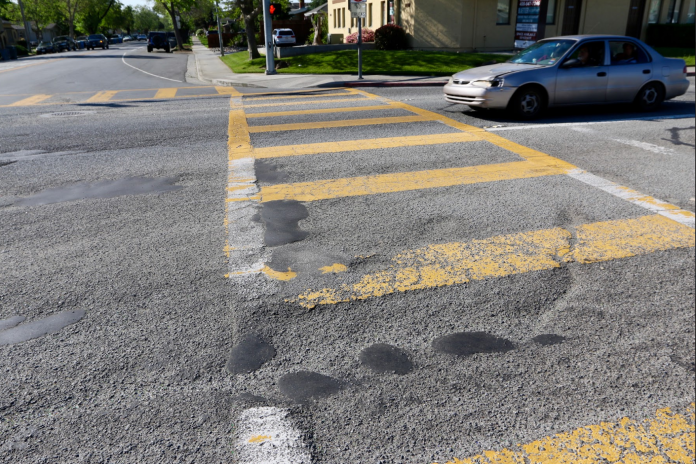While Gilroy residents lament the condition of the city’s roads, with plenty seeing them as minefields of potholes, a report presented to the City Council on Monday states Gilroy city streets are “good” but could be spiraling down if costly intervention is not taken.
Every two years, the city’s public works department and city engineers compile a State of the Streets report, which evaluates road quality based on observable conditions such as cracks, potholes and patches, and then calculates an overall score called, Pavement Condition Index (PCI).
This year, Gilroy’s 264 lane miles of paved roads, not including alleys, received an average PCI of 66, a significant drop from four years ago, when it was 76, and less than the city’s goal of an average PCI of 70.
For Gilroy to maintain an average PCI of 70, the public works team told the council, the city needs to spend $3.3 million per year on road maintenance, a leap from current funding levels of $300,000.
“It’s the worst I’ve seen in my lifetime,” said Mayor Perry Woodward, a native Gilroyan, in an interview. “We always did a pretty good job keeping our streets maintained. And to me, this is as bad as I’ve seen.”
The city used to “chip seal” Gilroy streets every seven years, said Councilmember Dion Bracco during Monday’s session, as he asked the public works team about current maintenance practices.
Senior civil engineer and co-author of the report, David Stubchaer said complaints over flying bits of gravel caused the city to move to a more expensive but effective chip slurry seal treatment.
When Councilmember Daniel Harney asked about any cost savings related to the decrease in the cost of oil, Stubchaer explained that despite the per-barrel price of oil plummeting, the price of asphalt is actually at an all-time high.
“It’s vicious, isn’t it?” said Stubchaer.
Additionally, as the city grows, the maintenance cycle increases as more street miles are added to the system, added public works director, Rick Smelser.
“Instead of getting back to streets every seven years,” said Smelser. “it’s now every 12 to 15 years.”
Stubchaer also noted that major projects—like the one currently underway on Luchessa Avenue, takes away maintenance funds from other streets.
It is a lot more expensive to reconstruct a road, explained Stubchaer.
To local motorists, Gilroy’s “good” PCI score of 66 may seem incomprehensible, but two years ago that was the average rating of the entire nine-county, Bay Area road system, according to the Metropolitan Transportation Commission.
“We might be pretty good compared to Morgan Hill or Palo Alto,” said Woodward. “Every community is dealing with the same issue. So we may be pretty good compared to our peers but that’s not the measure I’m using.”
The “good” rating also does not help the motorists who have had to spend money on damage they attribute to the city’s pothole-laden streets. According to 2015 TRIP data, poor roads cost California drivers as much as $1,044 a year in extra vehicle operation costs.
“The drivers are paying the costs,” said Woodward. “I get calls all the time, ‘I damaged my car.’”
He adds: “I hear you. I hear you. But we’re in a quandary.”
That quandary is a funding shortfall. According to the authors of the city’s roads report, a one-time injection of $500,000 to the pavement maintenance program in fiscal year 2017 would increase the city’s average PCI by just 1 point, assuming current funding levels stay the same.
And if Gilroy were to budget the $3.3 million per year to achieve their desired PCI of 70, the city would still have deferred maintenance costs, currently at $15 million.
“Even if you put $3.3 million a year to achieve and maintain a PCI of 70, that is not enough to meet the deferred maintenance costs down the line,” said Stubchaer.
The report included three funding scenarios, looking at what would happen to overall street conditions over the next 15 years if funding levels stayed the same, were cut entirely or funded well enough for the city to reach a PCI of 70.
If the city continues current funding levels of approximately, $300,000 per year, in 15 years, the average PCI will drop from 66 to 34, considered “poor.” Deferred maintenance costs would also jump from its current $15 million to $157 million.
In the “do-nothing” scenario, when no pavement maintenance is performed, the average PCI plummets from 66 to 27 at the end of 15 years, and deferred maintenance costs come in at a hefty $175 million.
The report calls investing $3.3 million each year for the city to maintain the PCI 70 rating, the “most efficient scenario;” at the end of 15 years, it has the lowest deferred maintenance costs of $56 million.
Costs
Approximately $300,000 per year is spent on pavement maintenance, with the majority of that funding received from the state’s gas tax, which was recently decreased by the State Board of Equalization to an all-time low of 28 cents per gallon.
The board’s action, according to a report by the Associated Press, will reduce the amount of money going toward the state’s roads and mass transit programs by approximately $328 million next year.
And while agencies responsible for pavement maintenance experience ongoing decreases in fuel tax revenues, even as costs increase “at an exponential rate due to pavement degradation,” the report notes there are no mechanisms in place to increase pavement maintenance funds.
“I want to spend at least $3 million a year so it doesn’t get worse,” said Woodward about the state of the roads. “The problem is there’s no money. So what do you do? Honestly, I don’t have an answer.”
In 2014, a local sales tax ballot initiative, Measure F, was introduced to improve local quality of life and maintain essential city services. The half-cent sales tax increase was expected to bring in $107 million of sales tax revenue over the course of 15 years, but voters defeated it.
“We tried two years ago,” said Woodward. “Measure F would have provided $107 million to fix some of these problems or at least ameliorate some of these problems, and that didn’t pass. I think we need to have a heart-to-heart as a community about where the money is going to come from.”
What about First Street?
Gilroyans also learned Monday that upgrades to First Street—the stretch of Highway 152 controlled by Caltrans, would likely be delayed until 2020 or 2021.
Over the past couple years, according to the report, city staff have been working informally with Caltrans to coordinate a 24-inch waterline replacement project for First Street.
While that project is expected to be completed by the end of the year, the report notes that initial discussions with Caltrans staff failed to produce a firm commitment to repave First Street, prompting city staff to reach out to Caltrans management and State Senate and Assembly representatives to help address the issue.
City staff wanted Caltrans to start the Capital Preventive Maintenance Project (CAPM), which would include First Street (and part of Hecker Pass Road) from 0.3 miles west of Santa Teresa, continuing east to U.S. 101, after the waterline replacement was complete.
The city was informed in February that because of decreased funding and competing needs, CAPM would not be undertaken until fiscal year 2020 or 2021.
City staff is looking into other ways of funding the much-needed upgrades to First Street.
“First Street has a PCI of 53,” Councilmember Roland Velasco wrote on Facebook. “Caltrans is responsible for the repair and maintenance of First Street and they don’t anticipate repairing the street until 2020/2021. This is unacceptable to me. Staff is working with VTA to try to identify funds to repair First Street and then have Caltrans reimburse VTA.”














